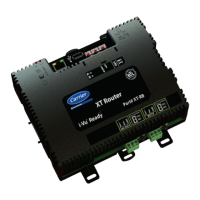i-Vu® XT Router (drv_gen5) CARRIER CORPORATION ©2022
Installation and Start-up Guide 17 All rights reserved
To connect the i-Vu® XT Router to the Ethernet
Connect an Ethernet cable to the Gig-E Ethernet port.
If your system has multiple routers that reside on different IP subnets, you must set up one router on each IP
subnet as a BACnet/IP Broadcast Management Device (BBMD).
Every subnet with a router must have a BBMD configured in order for broadcasts from routers on that subnet to
reach the rest of the routers on the network.
NOTES
• The i-Vu® Standard or Plus application - If the i-Vu® web server is on a separate subnet than the rest of the
routers, the internal router must be assigned a routable IP address and configured as a BBMD.
• The i-Vu® Pro application - If the i-Vu® Pro server is on a separate subnet than the rest of the routers, you
must register it as a foreign device to a router acting as a BBMD device.
Use the BBMD Configuration Tool to:
• Write/read the Broadcast Distribution Table (BDT) of each BBMD device
• Allow controllers on one subnet to communicate with controllers on other subnets
• Enable the i-Vu® application to see, upload, or configure controllers on different subnets
To wire to a BACnet/ARCNET network
1 Turn off the i-Vu® XT Router's power.
2 Check the communications wiring for shorts and grounds.
3 Connect the communications wiring to Port S1’s screw terminals labeled Net +, Net -, and Shield.
NOTE Use the same polarity throughout the network segment.
4 If the router has a Port S1 Configuration rotary switch, set it to 2.
5 If the i-Vu® XT Router is at either end of a network segment, set the port's End of Net switch to Yes.
NOTE The router’s End of Net switch applies network termination and bias. See the Open Controller Network
Wiring Guide.
6 Turn on the router's power.
7 To verify communication with the network, get a Module Status report in the i-Vu® interface for a router on
the ARCNET network.
NOTE This step requires that you have discovered and uploaded the router in the i-Vu® application.

